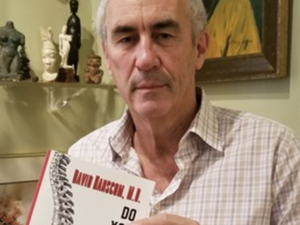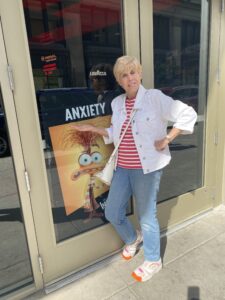This article was written by a journalist that I met in New York City about five years ago. My wife and I met her at the end of a long day at a publicity summit. After talking to so many people, we were a bit tired, but she instantly energised us with her interested in my work and its ramifications. What she really liked was that Babs is a professional tap dancer. We have stayed in touch and have become good friends. As busy as I am, I feel like I am standing still next to her. She has boundless energy, is full of optimism, and continues to inspire me.
This is the article she wrote for her column last fall based on a conversation over lunch with Babs and me in NYC. I am impressed how she condensed our rather long dialogue into a clear set of thoughts and I wanted to share it with you.
Enjoy your Memorial Day weekend, which is also sobering in light of the sacrifices made by so many for our freedom.
DEAR FRIENDS,
One of my most circulated newspaper columns, over Northern Ontario, and many responses from readers! I am delighted to share this with you.
xox Bonnie
Kogos: Why anxiety is the real gift of life
Learning, at this golden stage of life, about what a renowned doctor calls repetitive unpleasant thoughts, or RUTs.
Author of the article: Bonnie Kogos Columnist, Published Nov 13, 2023

David Hanscom, a complex-deformity spine surgeon of 30 years, visits Bonnie in New York City, showing her his second book, Do You Really Need Spine Surgery, and discussing an important question in today’s complicated world.
With world events, local reactions to these events, oncoming seasonal disorders, the approach of the holiday season, COVID and flu worries, I’m delighted that Dr. David Hanscom is here for lunch with his wife.
David is a highly respected back surgeon who has, over the years, been teaching us more about our thoughts, bodies, health, learning and creativity.
David has been teaching and inspiring people to break free from mental and physical pain and says this has been the most rewarding phase of his career. His books that have helped many are, Do You Really Need Spine Surgery? and Back in Control: A Spine Surgeon’s Roadmap Out of Chronic Pain.
We have a great friendship and he has allowed me to interview him for years. While we speak of many things, I’ve got to ask: “David, these days, in our everyday lives, why is it so painful for so many, to constantly feel anxious?”
He’s quiet and thoughtful.
“Bonnie, anxiety is the real gift of life,” he says.
“What?”
I try not to laugh and then shut up. An amazing lesson is coming.
“This is created by many sensations from our unconscious nervous system. Every living creature, from one-cell organisms to mammals, continually processes input from its surroundings,” David says slowly. “This helps us to navigate challenges to remain alive. Our nervous system processes input from outside the body and from sensations arising from within.
“Nervous systems have evolved, as the complexity of organisms has required this … and central nervous systems gradually emerged. For us human beings, language is a recent development that has allowed us to cooperate, physically thrive, and engage in complex abstract thinking.”
“More, please,” I request, softly.
“Our interoceptive nervous system receives signals from our internal organs and is intertwined with every cell in our body. The interaction of these signals with the nervous system helps give us rise to consciousness. Warning signals, evolved to be intensely unpleasant, compel us, as the organism, to optimize function and act to survive.” Humans, with language, give meaning to them. The more well-intentioned you are, the more personally and intensely you react to these sensations.
I sit across from him. Not writing. Breathing slowly, listening.
“Conversely, Bonnie, sensations of safety are equally as powerful to drive cooperation and reproduction. The reward and our warning system are both always active and in a delicate balance. Our finely tuned interactions allow us immediate action to avoid threats and seek safety.”
“Okay, I understand our primary need is survival, so in time of need, unpleasant sensations are more frequent.”
“Most of the time. However, your actions can minimize them quickly. Avoiding physical pain and unpleasant sensations is how we’re programmed to stay alive,” David says. “Yes, Bonnie, this powerful complex unconscious system is, truly for all of us, the gift of life.”
“So, must we learn to love anxiety?”
“Absolutely,” David laughs. “With our ability in language, we possess what I call ‘cognitive consciousness,’ which is the capacity to describe these sensations. Meaning is given to our feelings, generated by these neurochemical reactions that reflect danger and safety.
“Realistically, we’re always on some degree of alert for trouble, and there can be an endless stream of repetitive unpleasant thoughts. We call them RUTs, which are repetitive unpleasant thoughts. And with physiology, how your body functions, these can affect every cell in your body.
“It’s all-encompassing. It can feel like who you are and becomes a core part of your identity. So, dear Bonnie, the gift of life translates into the ‘curse of cognitive consciousness’.”
He continues.
“Our brains become inflamed and hyper-reactive with excitatory neurotransmitters and inflammatory cells when we’re in flight or fight physiology. Humans describe these sensations generated from an activated threat response, as in anxiety and anger,” David says. “Yet these are physiologic states (how the body functions) and not psychological.
“Blood flow in the brain can shift from the neocortex, our thinking centres, to the limbic system, which is our fear and survival regions. So, you might not think as clearly when you’re under real or perceived stress. An inflamed brain fires up even more RUTs, which are also perceived as dangerous and there can be no end to this cycle.”
I sigh.
“Bonnie, RUTs can make life miserable for many people,” David says. “For me, they were by far and away the part of my personal 15-year ordeal suffering from chronic pain. Although humans have the capacity to escape from physical pain, there is no escape from mental pain. Suppressing RUTs fires them up even more.
“Trying to cope with them can lead to many ineffective and destructive behaviours. Not being able to tolerate the barrage of intrusive thoughts is what led to my near suicide in 2002.”
“What, you?” I blurt. “You’re so calm and a well-established medical and behavioural authority, who teaches and leads groups.”
“The mental health world considers RUTs to be unsolvable,” David says, “But so what? While I no longer experience them, I’ve been able to help many others escape and thrive. The initial step is learning that anxiety and anger are what you have and not who you are. You’ll learn to work them instead of fighting them.”
I am delighted that David Hanscom has created a successful multi-pronged self-directed approach as an app and online course called, The DOC (Direct your Own Care) Journey.
Here’s a link to these resources: backincontrol.com/resources-2/. Access more at www.backincontrol.com and hit the “resources” link at the top of the page.”
A poem on my mirror by Rainer Maria Rilke reads, Let everything happen to you. Beauty and terror. Just keep going. No feeling is final.

Our Bonnie, in her 32st year in the Window Seat, realizes that when you’re through changing, you’re through. Find her at BonnieKogos@gmail.com
